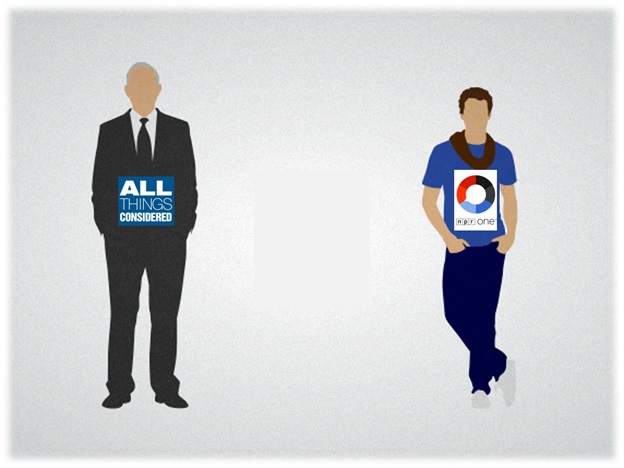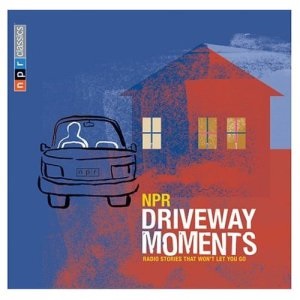
“The End of All Things Considered.” It was a headline in Slate without a question mark. A statement. And when I wrote this post, nearly 200 people had already left comments, opining about on-demand audio and the future of the curated radio magazine show.
A number of friends and readers of this blog shared this well-thought-out article with me, written by Steve Lickteig. It suggests that “linear” or real-time radio is on the endangered list, especially among Millennials who simply won’t put up with curated content they cannot personalize and control. Lickteig says that voice recognition software (Siri, Alexa, etc.) is already acting as digital content servants, aggregating the content we want, while leaving out the parts we don’t.
He also mentions the NPR One app as an example of technology that is well on its way to disrupting that network’s own news magazines – Morning Edition and All Things Considered – often referred to as “tent poles” because of their historically strong ratings performance in the morning and afternoon drive dayparts.
This isn’t a conversation about podcasting which has always had a certain clunkiness. It’s about on-demand audio content seamlessly delivered via voice command, and how consumers can use that technology to pick and choose their desired programming, while filtering out the material that doesn’t interest them. It goes well beyond listening to 40 minutes of some guy in Poughkeepsie rambling on about his craft beer preferences in his podcast, or even Marc Maron interviewing an interesting celebrity.
This is about the changing ways in which we feed our information and entertainment habits. And while Millennials lead the way in the customization revolution with apps like Spotify, curated content, whether driven by algorithms or humans is still a highly popular option, whether it’s from NPR One, Pandora, or on the radio.
To his credit, Lickteig acknowledges that NPR continues to provide top-shelf news and information. In his words, it’s “not the journalism; it’s packaging.” He opines that in the future, consumers won’t sit through someone else’s idea of a news magazine when they can bark out orders and have that content menu instantly served up.
Many of the comments that accompany his article take exception to this premise. Some argue that NPR is different, and that their superior brand of journalism transcends personalization patterns. As much as many consumers enjoy customization, the element of surprise matters, especially for a classy news organization like NPR. Multiple times each week, I’ll hear a story on one of its news magazines that initially sounds boring or irrelevant. But 30 seconds in, I’m riveted by the story and the treatment. And in the process, I’m learning and discovering something I didn’t know.
That element of surprise – whether you’re a Boomer or a Millennial – is about those pleasant, captivating, serendipitous moments that keep radio listeners coming back for more. That’s true whether you’re listening to All Things Considered or Dave & Chuck the Freak.
 NPR calls these “driveway moments,” where you can’t leave your car or your home because you’re so caught up in a story, a feature, or an interview. Radio’s future isn’t just about making its content on-demand. It’s about creating enough true discovery moments to keep consumers engaged – whether we’re talking about a great story on The Moth Radio Hour or a hilarious caller on The Eric & Kathy Show.
NPR calls these “driveway moments,” where you can’t leave your car or your home because you’re so caught up in a story, a feature, or an interview. Radio’s future isn’t just about making its content on-demand. It’s about creating enough true discovery moments to keep consumers engaged – whether we’re talking about a great story on The Moth Radio Hour or a hilarious caller on The Eric & Kathy Show.
It’s part of what the NPR One team grapples with every day as users routinely skip stories within the first few seconds they start streaming. The smart move is devising multiple strategies for the same programs aimed at different content consumption preferences. In a more choice-filled world, it means creating different ways, places, and formats for enjoying the same stories. Some you choose, some are served up, some have videos, and some are totally interactive.
Interestingly, ratings for NPR’s news magazines are on the rise, perhaps fueled by better on-air marketing and a Presidential election that demands clarity, objectivity, and great reporting. Whatever the case may be, consumers continue to enjoy curated news magazines.
Lickteig suggests younger consumers don’t care about information discovery, but is that simply an outgrowth of voice recognition technology that might make it ironically more challenging to discover new concepts, new philosophies, or even new bands when everything is “skippable?”
Or is it the fault of media content creators and marketers who fail to make the case for the joys of finding out about new things? It takes work, effort, and creativity to craft content that exudes discoverability.
Radio programmers can no longer mechanically create content in “the way we’ve always done it” mode, and expect to continue to thrive in an on-demand, voice recognition environment. But they also can’t market the same old way either, ignoring these shifting usage patterns and the technology that makes it all possible. It’s about understanding how consumers are using media, and designing marketing messages that enhance the assets of a media organization like NPR.
We live in a world where no one wants to feel left behind or out of it. In today’s parlance, it’s about FOMO – or fear of missing out. When shows are as good as All Things Considered, those trendy four letters mean a lot.
Voice recognition software, personalization, and customization are wonderful things that are part of the new arena of content consumption. But when they lead to missing out on something really cool, smart, insightful, or surprising, what’s being lost in the technology translation?
On a somber note, an NPR photojournalist, David Gilkey, and interpreter, Zabihullah Tamanna, were both killed in Afghanistan while on assignment last weekend. I was fortunate enough to see Gilkey speak at the PRPD Convention in Portland back in 2014. We blogged about his panel, featuring NPR journalists and correspondents who risk their lives to bring us top-notch news coverage. I’ve been thinking about that session and the brave reporters and correspondents who talked to us a lot these past couple days. Condolences to both of these guys, their families, and their colleagues at NPR.
- What To Do If Your Radio Station Goes Through A Midlife Crisis - April 25, 2025
- A 2020 Lesson?It Could All Be Gone In A Flash - April 24, 2025
- How AI Can Give Radio Personalities More…PERSONALITY - April 23, 2025




Great article Fred. Something you touch on, but I think is worthy of a more in-depth analysis (if it hasn’t already been done), is *why* most of the shift in media has given control the consumer.
Sure, there’s been major advances in technology, but that’s the *how*, not the *why*.
The *why* is because people have, for the most part, completely lost any trust in the media. Nobody trusts their media outlets to provide them with what they want anymore. When there were only two or three TV stations in a market, most of those stations took that obligation to serve their viewers very seriously…and the viewers trusted the stations to do so. That largely evaporated in the 80’s and 90’s as stations found – through deregulation and “going public” – that’s it’s more profitable to screw your consumers than it is to serve them. So along comes the tech in the 00’s that allows consumers to bypass all the crap and, surprise surprise, they start using it!
However, there is still a media entity out there where, for the most part, its consumers DO still trust them. And where, for the most part, the media entity (really “entities”) takes that trust pretty seriously and works to earn it. In no small part because their business model is built around earning that trust. And where people are still willing to forgo a lot of control and tell that media entity “I’ll trust you to, on the whole, give me stuff that I’ll be interested in.”
Care to take a guess what this media entity is? 🙂
Aaron, thanks for the insightful comment. I have faith that public radio in general, and NPR specifically, has the trust and the smarts to figure it out. And in the process, they may help lift up the rest of the radio industry. The NPR One app and their leadership in the podcast space are two key factors in changing the game for traditional media outlets. Appreciate you taking the time.
Great Great thoughts…..you have summed up the essence of why we are here, and for a whole lot of us, why we got into this business in the first place.
Your blog begs the question….How many driveway moments did we have at our stations today!!!
Thanks!
Mary, many thanks. It’s a tough question but a fair one. And yes, we clearly need to make more. Thanks much for reading our blog and chiming in.
Technology has certainly changed the way that consumers seek out media. But, while FOMO (fear of missing out) is one way to look at producing great content, how about adding FOLAN (fear of learning anything new) and FOLAA (fear of learning anything at all). Cable news channels and internet chats tell us that many people are predisposed to choose content that reinforces what they already believe, or want to believe. Perhaps the greater challenge is to create driveway moments in such a way as to compel the listener to reach beyond their comfort zone and experience something new.
Gerry, I think you’ve hit on the struggle that faces NPR and public radio, in particular. It’s the balance between giving listeners what they want, wherever and whenever they want balanced against their core value of learning. That’s the “secret sauce” that has put public radio in the position it’s in today. Technology, ease of use, and seamless user experience may be a pathway to attracting Millennials, but something is lost in translation. More and more, their “comfort zones” are more heavily insulated. Thanks for the insightful comment.